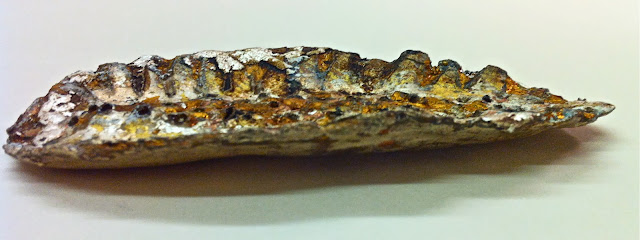A selection of necklaces, pendants, bracelets, bangles and earrings that I have been making recently. I am so enjoying making papier mache beads and pushing the boundaries of papier mache. The papers I am using are Tyvek paper and iridescent tissue, both of which I heat shrink rather than glue together. I also have used air dried papier mache clay that I paint with acrylic inks and coat with matte acrylic varnish and/or epoxy resin and added Japanese seed and bugle beads that are silver lined and that I encourage to oxidize to add a certain aged quality that is in sympathy with the fragments of 17th century clay pipes that you will see in some of the pieces. I thread the beads onto Beadalon 7 strand nylon coated stainless steel wire. I use silver plated clasps on my pieces as I am putting the value into creativity rather than precious metals but will use Sterling Silver when requested.
Iridescent papier mache + matte papier mache paste beads + Japanese silver lined glass beads. I like to let the silver lining oxidize so that it echoes the necklaces that I find so inspiring in the Etruscan and Greek rooms in the British Museum.
Double stranded necklace with fragments of river washed 17th century clay pipes from the River Thames. The original colour of clay pipes was off white. Some fragments have become discoloured over time by absorbing the beautiful blue/grey clay river silt or ochres from lying next to rusting metal - rusty nails from the hulls of old wooden boats etc.
The above necklace was made to remind me of wonderful necklace I saw in Burlington Arcade in London made from large and irregular shaped fresh water Baroque pearls. I heat shrink Tyvek paper and iridescent tissue and then either dip them in resin or paint them with gloss varnish. They also look really good when they have a coat of matte varnish on or a mix of the two.
Source: Uploaded by user via Hilary on Pinterest
Iridescent papier mache + matte papier mache paste beads + Japanese silver lined glass beads. I like to let the silver lining oxidize so that it echoes the necklaces that I find so inspiring in the Etruscan and Greek rooms in the British Museum.
Source: Uploaded by user via Hilary on Pinterest
Double stranded necklace with fragments of river washed 17th century clay pipes from the River Thames. The original colour of clay pipes was off white. Some fragments have become discoloured over time by absorbing the beautiful blue/grey clay river silt or ochres from lying next to rusting metal - rusty nails from the hulls of old wooden boats etc.
The above necklace was made to remind me of wonderful necklace I saw in Burlington Arcade in London made from large and irregular shaped fresh water Baroque pearls. I heat shrink Tyvek paper and iridescent tissue and then either dip them in resin or paint them with gloss varnish. They also look really good when they have a coat of matte varnish on or a mix of the two.
Source: Uploaded by user via Hilary on Pinterest
Source: Uploaded by user via Hilary on Pinterest
I flattened some of the beads just after heat shrinking the Tyvek paper and the painted them with French sepia ink and then heat shrunk some layers of iridescent tissue, bringing out the greens, golds and bronzes.
Necklace using iridescent and squeezed papier mache beads.
brooch
pendant
Source: Uploaded by user via Hilary on Pinterest
Source: Uploaded by user via Hilary on Pinterest
Source: Uploaded by user via Hilary on Pinterest
Source: Uploaded by user via Hilary on Pinterest
Source: Uploaded by user via Hilary on Pinterest
Source: Uploaded by user via Hilary on Pinterest
Necklace using iridescent and squeezed papier mache beads.
Source: Uploaded by user via Hilary on Pinterest
brooch
Source: Uploaded by user via Hilary on Pinterest
pendant
Source: Uploaded by user via Hilary on Pinterest
Source: Uploaded by user via Hilary on Pinterest
Source: Uploaded by user via Hilary on Pinterest
Source: Uploaded by user via Hilary on Pinterest
Source: Uploaded by user via Hilary on Pinterest
Source: Uploaded by user via Hilary on Pinterest





















